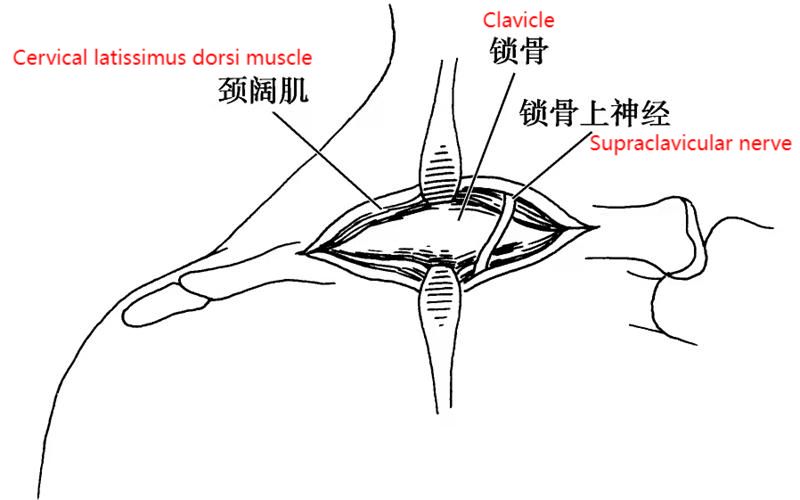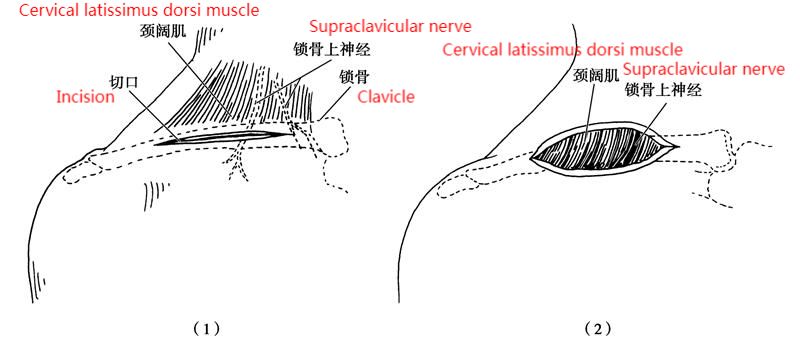· एप्लाइड एनाटोमी
क्लाभिकलको सम्पूर्ण लम्बाइ छालाको तलतिर हुन्छ र सजिलै देख्न सकिन्छ। क्लाभिकलको मध्य भाग वा उर्वर भाग खस्रो हुन्छ, यसको आर्टिक्युलर सतह भित्र र तलतिर फर्किएको हुन्छ, जसले गर्दा स्टर्नल ह्यान्डलको क्लाभिकुलर नचको साथ स्टर्नोक्लाभिकुलर जोइन्ट बन्छ; पार्श्व छेउ वा एक्रोमियन छेउ खस्रो र समतल र चौडा हुन्छ, यसको एक्रोमियन आर्टिक्युलर सतह अंडाकार र बाहिरी र तलतिर, एक्रोमियनसँग एक्रोमियोक्लाभिकुलर जोइन्ट बन्छ। क्लाभिकल माथि समतल छ र अगाडिको मार्जिनको बीचमा स्पष्ट रूपमा गोलाकार छ। तलको मध्य भागमा कोस्टोक्लाभिकुलर लिगामेन्टको कुनै न कुनै इन्डेन्टेसन छ, जहाँ कोस्टोक्लाभिकुलर लिगामेन्ट जोडिएको छ। तलको पार्श्वमा क्रमशः रोस्ट्रोक्लाभिकुलर लिगामेन्टको शंक्वाकार लिगामेन्ट र तिरछा लिगामेन्ट संलग्न भएको शंक्वाकार नोड र तिरछा रेखा हुन्छ।
· सङ्केत गर्छ
१. क्लाभिकल फ्र्याक्चर जसको लागि चीरा र घटाउने आन्तरिक फिक्सेसन आवश्यक पर्दछ।
२. पुरानो ओस्टियोमाइलाइटिस वा क्लाभिकलको क्षयरोगको लागि मृत हड्डी हटाउनु आवश्यक पर्दछ।
३. क्लाभिकल ट्युमरलाई रिसेक्शन आवश्यक पर्दछ।
· शरीरको स्थिति
काँधहरू अलिकति माथि उठाएर, सुत्ने स्थितिमा।
चरणहरू
१. क्लाभिकलको S-आकारको शरीर रचनामा एउटा चीरा बनाउनुहोस्, र क्लाभिकलको माथिल्लो किनाराको छेउमा रहेको चीरालाई भित्री र बाहिरी छेउमा घाउको स्थिति चिन्हको रूपमा विस्तार गर्नुहोस्, र चीराको स्थान र लम्बाइ घाउ र शल्यक्रिया आवश्यकताहरू अनुसार निर्धारण गरिनेछ (चित्र ७-१-१(१))।
चित्र ७-१-१ एन्टेरियर क्लाभिकुलर प्रकटीकरण मार्ग
२. छाला, छालाको तन्तु र गहिरो फेसियालाई चिर्नुहोस् र उपयुक्त भएसम्म छालाको फ्ल्यापलाई माथि र तल मुक्त गर्नुहोस् (चित्र ७-१-१(२))।
३. भास्टस सर्वाइसिस मांसपेशीलाई क्लाभिकलको माथिल्लो सतहमा काट्नुहोस्, मांसपेशी रक्तनलीहरूले भरिपूर्ण छ, इलेक्ट्रोकोगुलेसनमा ध्यान दिनुहोस्। सबपेरियोस्टियल विच्छेदनको लागि पेरियोस्टियम हड्डीको सतहमा काटिएको छ, भित्री माथिल्लो भागमा स्टर्नोक्लेइडोमास्टोइड क्लाभिकल, भित्री तल्लो भागमा पेक्टोरलिस मेजर क्लाभिकल, बाहिरी माथिल्लो भागमा ट्रापेजियस मांसपेशी र बाहिरी तल्लो भागमा डेल्टोइड मांसपेशी। पोस्टरियर सबक्लाभियन स्ट्रिप गर्दा, स्ट्रिपिंग हड्डीको सतह विरुद्ध कडा रूपमा प्रदर्शन गर्नुपर्छ, र नियन्त्रण स्ट्रिपर स्थिर हुनुपर्छ ताकि पोस्टरियर क्लाभिकलको रक्तनली, स्नायु र प्ल्युरालाई क्षति नहोस् (चित्र ७-१-२)। यदि प्लेटको स्क्रू फिक्सेसन लागू गर्ने प्रस्ताव गरिएको छ भने, क्ल्याभिकल वरपरका नरम तन्तुहरूलाई पहिले पेरियोस्टियल स्ट्रिपरले सुरक्षित गरिन्छ, र ड्रिल प्वाललाई अगाडि तलतिर निर्देशित गर्नुपर्छ, पछाडि तल होइन, ताकि प्लुरा र सबक्लाभियन नसामा चोट नलागोस्।
 चित्र ७-१-२ क्लाभिकलको पर्दाफास गर्दै
चित्र ७-१-२ क्लाभिकलको पर्दाफास गर्दै
पोस्ट समय: नोभेम्बर-२१-२०२३











